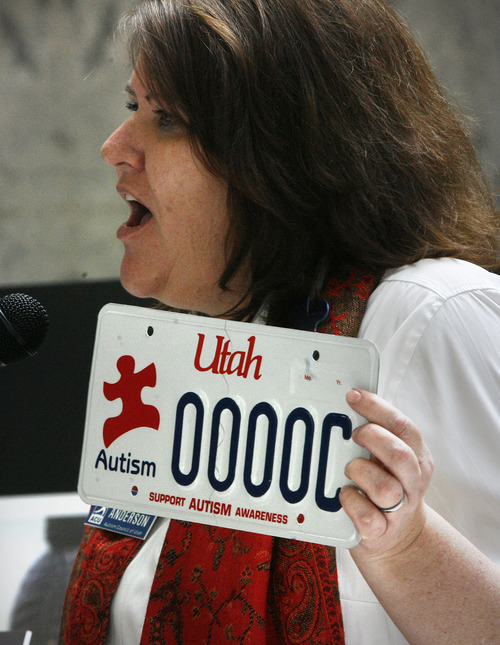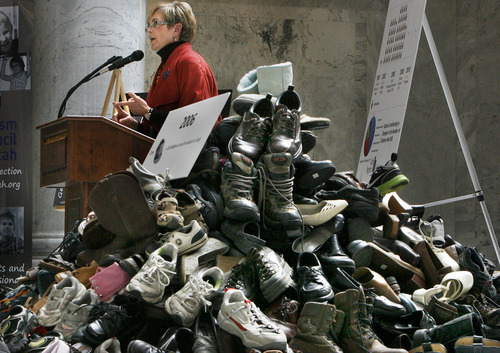This is an archived article that was published on sltrib.com in 2011, and information in the article may be outdated. It is provided only for personal research purposes and may not be reprinted.
Highlighting Utah's increasing autism rate, community leaders on Thursday urged residents to purchase awareness license plates to boost research, education and other efforts in the state.
"When you see these plates, give a honk, give a wave. We'd love to see everyone buy one," said Laura Anderson, president-elect of the parent-run Autism Council of Utah.
Legislation creating the plates went into effect in October, but they were not available for purchase until January. Since then, 27 have been sold, according to the Utah State Tax Commission.
The goal is to sell 2,500 by year's end, said Anderson.
The plates feature a red puzzle piece and the word "autism" in blue. They require a $25 initial contribution, a $10 special plate fee, and an ongoing $25 annual contribution.
The puzzle piece signifies the complexity of autism spectrum disorder, which is likely caused by a mix of genetic and environmental factors and marked by unusual behaviors and difficulty communicating.
"But when I see it, I see every person in the community who supports us and helps us bring the pieces of our puzzle together," said Amy Baker of Herriman, whose two sons, 7-year-old Bryson and 5-year-old Braden, have autism.
The funds raised go into an Autism Awareness Restricted Account, and are distributed to programs by the superintendent of public instruction. Deputy state superintendent Martel Menlove said rules governing how the money is used are still being written.
But Anderson said the funds will most likely go toward teacher training and public awareness. "We'd like to be able to give kids scholarships for [special early intervention programs] but there's not enough money. What we're looking at raising annually would cover one year for one child at Pingree," she said, referring to the Carmen B. Pingree School for Children with Autism in Salt Lake.
The Autism Council of Utah points to the plates as an important way to promote awareness and support autism programs in a time of budget cuts. Speakers at an afternoon press conference at the state capitol highlighted the growing prevalence of autism.
One in 2,500 Utah children were estimated to have autism spectrum disorder in 1987. Those numbers increased 20-fold by 2002 to 1 child in 133.
In 2006, Utah's rate rose to 1 in 85 children.
New estimates for 2008 are due out this summer, said Judith P. Zimmerman, director of the Utah Registry of Autism at the University of Utah.
Nationally, some experts have explained autism's meteoric rise as being due solely to increased awareness and a broadening of the disorder's definition. Zimmerman said that explains some of the increase, but not all. One study suggests 44 percent of the increase in autism simply can't be explained, she said.
Research at the U. has established that Utah has the third-highest rate of autism in 14 sites studied by the federal Centers for Disease Control and Prevention, looking at children born in 1994.
"They are in our circle of friends, our families, our loved ones and our community," said Zimmerman.
Last year, U. researchers received a $2.4 million grant to analyze the medical and education records of children born in 2002 and 2004, to determine whether they met the definition of having an autism spectrum disorder (ASD) at age 8.
The U. also plans to look at the prevalence of autism spectrum disorders among 4-year-olds in Tooele County and in Salt Lake City and Granite school districts. Researchers hope tracking the 4-year-olds as they grow older will help them understand long-term outcomes. —
What are autism spectrum disorders?
The disorders are developmental disabilities that can cause significant challenges in social interactions and communication. Children with the disorders handle information in their brain differently from other people, and might have unusual ways of learning, paying attention and reacting to different sensations. A broader category of pervasive developmental disorders includes autistic disorder, Asperger's syndrome, and pervasive developmental disorder-not otherwise specified.
Learn more
» For information on the University of Utah's work on autism, visit http://medicine.utah.edu/autismresearch/.
• For more about Utah's autism registry, visit http://health.utah.gov/autism/.
• Visit the Autism Council of Utah at http://autismcouncilofutah.org/.
• Autism awareness plates may be personalized. For more information, visit http://dmv.utah.gov/licensespecialplates.html or http://www.autismcouncilofutah.org. —
Autism in Utah
Utah has the third highest rate of autism spectrum disorders in 14 sites studied by federal researchers. The study found:
1 in 133 Utah children has an ASD
More than 1 percent (1 in 79) of Utah boys born in 1994 have an ASD.
Utah boys are 6½ times more likely than girls to have an ASD.
Autism is the fastest-growing serious developmental disability in Utah.
Autism is 20 times higher in Utah than it was 20 years ago.
Source: Utah Registry of Autism and Developmental Disabilities









